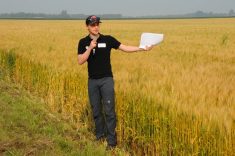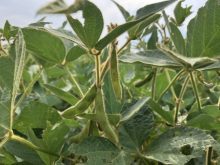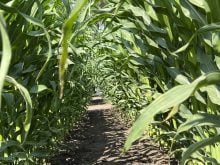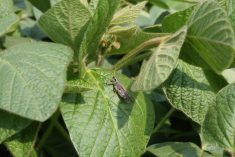The quest for a Western Prairie comeback faces challenges
Seed companies continue to improve their early-maturing soybean varieties, but no one is holding their breath for a rebound west of the Manitoba border.
“That whole Saskatchewan market has kind of faded away, so a lot of the really early genetics are just kind of sitting on the back shelf, and nobody’s really been asking for them a whole lot,” said Brad Pinkerton, Manitoba marketing rep for SeCan seeds.
Other stories in the New Seed Variety Guide 2025:
- What crop traits are on your wish list?
- Rethinking oats
- Phenotyping a la carte
- Durum variety designed for higher food fibre
- Genetic modification, global trade and illegal seed concern seed growers
In 2017, Saskatchewan planted 850,000 acres of soybeans. With the earlier maturing varieties and the wetter cycle the prairies were in at that time, Alberta farmers were even coming on board. But since then, the bottom has dropped out of the market. According to Soy Canada, in 2023, Saskatchewan soy acres had collapsed to 68,000 acres. And no one is growing them in Alberta any more.
Read Also

Feds propose overhaul of chronic wasting disease control program
Chronic Wasting disease control program getting updated by Canadian Food Inspection Agency with feedback encouraged from producers.
Because of the very wet spring, there has been talk suggesting the Prairies might have turned a corner this year and that we might be emerging from the dry cycle we’ve been in for the past five years. But according to Pinkerton, that’s not enough to move the needle.

“We sure miss having a couple hundred thousand acres of beans in Saskatchewan, but we need those August rains. And until we get August rains in Saskatchewan, it’s tough to convince people to grow soybeans in Saskatchewan,” said Pinkerton.
Pinkerton said SeCan has a robust portfolio of triple-zero varieties that are tall, early maturing, and well-suited to take up the slack if westward demand begins to grow again.
“We have one new one called Alouette R2x that is early and taller,” said Pinkerton. “We just got it out to the field this year, so we’re really learning about it this year, and we’ll know a lot more about it this fall, but it’s so far, it’s looking really good.
Over at Northstar Seeds, NSC Dauphin is the earliest maturing variety in their portfolio.
“It’s a 0008, and it can grow and mature in most areas across western Canada,” said Travis Williams, CEO of Northstar Seeds.

When discussing varieties, Williams objects to the term “early maturing” because it depends on where the crop is grown.
“Our next earliest is NSC, Arden. It’s a 002, so it would be suited for most areas in Manitoba,” he said. “It’s later maturing in the North, but it would be your early bean in southern parts of the Interlake and central Manitoba. It’s all relative.”
He notes that Tennessee Holland, Northstar’s most popular bean, would be considered an early-season bean in the Red River Valley and a late-season bean in the mid-north/Dauphin area.

“We’re evaluating experimental varieties that are also triple zero to see if we can find even stronger varieties for Western Canadian farmers,” said Williams.
Nutrien Ag Solution’s Proven Seed launched two new “ultra-early” varieties last year. PVS0007-X74, and PVS0009-X84.
“These are both Roundup Ready 2 Xtend varieties and are well suited and will help drive new acres outside of Manitoba and some of the nontraditional growing areas,” said Wilt Billings, product manager for corn and soybeans for Nutrien Ag Solutions.
Billings said both varieties are excellent yielding for maturity and both come with solid defensive traits, including resistance to phytoplasty, sclerotinia, white mold and IDC.
“For earlier maturities, they are big plants,” said Billings. “They have robust early growth and push through tough ground really easily, making them well suited to new soybean zones.”

But Billings says the early-season varieties can play a role in any region.
“There are many different uses for a triple zero variety. Bean growers can get their harvest started a little bit earlier. They can also hedge against the moisture requirements by planting a little bit of an earlier-season product,” he said. “If we don’t get those late season rains like we’ve had over the last couple of years, the ultra early products perform very well in terms of yield potential, and it’s just hedging against Mother Nature by growing both an early and a late season variety.”
Billings is hopeful for a rebound in soybean acres west of the Manitoba border, but he says it’s a long game. He says in speaking to growers in Saskatchewan and Alberta, he’s hearing there is demand for an alternative pulse crop to help with some of the disease rotations.
“I think it’ll be a more moderate uptake of soybeans as we move across Western Canada. Demand is still there, albeit it’s smaller than five or seven years ago.”
















